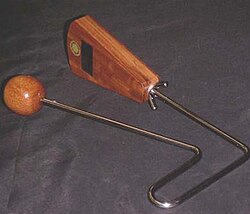Vibraslap
 A vibraslap manufactured by Latin Percussion |


The vibraslap is a percussion instrument consisting of a piece of stiff wire (bent into a U-shape) connecting a wooden ball to a hollow box of wood with metal “teeth” inside. The percussionist holds the metal wire in one hand and strikes the ball (usually against the palm of their other hand). The box acts as a resonating body for a metal mechanism placed inside with a number of loosely fastened pins or rivets that vibrate and rattle against the box.[1] The instrument is a modern version of the jawbone.[2]
Invention[]
The vibraslap was the first patent granted to the instrument manufacturing company Latin Percussion.[3]
The vibraslap was invented by Martin Cohen in 1967.[4] Cohen was told by percussionist Bobby Rosengarden, "If you want to make some money, make a jawbone that doesn’t break." About the inventing process, Cohen remembers, "I had never seen a jawbone before, but I had heard one on a Cal Tjader album. I found out that it was an animal skull that you would strike, and the sound would come from the teeth-rattling in the loose sockets. So I took that concept and invented the Vibraslap, which was my first patent."[5]
Origins[]
The vibraslap descended from the African "jawbone". This is the lower jawbone of a donkey or a zebra which has loose teeth that rattle when the instrument is struck.[6] The Instrument was carried by slaves to South America where it became known as the Quijada.[7]
Differing names[]
The vibraslap comes in a variety of sizes and materials and is sometimes marketed under the name "Donkey Call","Donkey Rattle", "Chatterbox" or "Rattleslap."
Examples in well-known music[]
This section needs additional citations for verification. (August 2018) |
The Vibraslap can be heard very clearly on the 1967 US No. 1 hit single "Green Tambourine" by The Lemon Pipers and is frequently and prominently used in the music of the alternative rock group Cake. It can be heard on a number of famous rock songs like "Crazy Train" by Ozzy Osbourne, "Sweet Emotion" by Aerosmith, "Closer to the Heart,” by Rush, ”Orange Crush" by R.E.M., "A Change of Seasons" by Dream Theater, "Feelin' Alright" by Joe Cocker and throughout the aptly titled "" by America. It can also be clearly heard near the beginning of "The Low Spark of High Heeled Boys" by Traffic, signalling the end of the prolonged fade-in and the start of the signature piano vamp. Also notable: Brian Jones of The Rolling Stones played the vibraslap in the Jimi Hendrix song "All Along the Watchtower"; it is the thwack sound heard at the end of each bar in the intro.[8] The Vibraslap is also used in the songs "Billionaire" by Travie McCoy, "You're In" by Kimya Dawson and "I Don't Like It, I Love It" by Flo Rida. It can also be heard in "Kokomo" by The Beach Boys, "Asesina" by Okills, as well as in "Teenagers" by My Chemical Romance. The instrumental theme to the television show "Room 222" featured the sound of a Vibraslap at regular intervals throughout the song. The 1992 hit "Nuthin' but a 'G' Thang," by Dr Dre and Snoop Doggy Dogg, also prominently features the sound of the vibraslap. Carl Palmer, drummer and percussionist with Emerson, Lake & Palmer made use of the vibraslap. Other tunes which include the Vibraslap are "Rude 69" by Let's Go Bowling, "A Fifth of Beethoven" by Walter Murphy, "I Don't Know" by Paul McCartney, "Shouldn't Judge a Man" by Skankin' Pickle, "Gone Campin'" by Harry and the Potters, and even "Feels Good" by Tony! Toni! Toné!. British band Kasabian have also used the vibraslap on a number of songs, including "Fire", "Where Did All The Love Go?" and "treat".
While recording Sweet Emotion, Steven Tyler broke the vibraslap on the third attempt at using it. You can hear the break on the recording.[citation needed]
Sufjan Stevens used a vibraslap during live performances of some of his songs, most notably "Carrie & Lowell".[citation needed]
The vibraslap can also be heard in the theme music to the popular Channel 4 game show Countdown and is also prominently heard in the music played whilst the Countdown clock is running.[9]
References[]
- ^ "Vibra-Slap", Music.VT.edu. URL last accessed December 11, 2009.
- ^ "Donkey Call or Vibraslap". Ethnic Musical Instruments.com. Retrieved April 26, 2015.
- ^ "LP Vibra-Slap II - Standard Wood (LP208)", SteveWeissMusic.com. URL last accessed December 11, 2009.
- ^ "USPTO", USPTO.
- ^ "PASIC 2012 Archived August 24, 2014, at the Wayback Machine", PAS.org. URL last accessed December 11, 2009.
- ^ Karl Peinkofer and Fritz Tannigel, Handbook of Percussion Instruments, (Mainz, Germany: Schott, 1976), 159.
- ^ Afro Peruvian Percussion & the Cajon: Basic History & Rhythms Accessed online February 24, 2015,
- ^ Padgett, Ray: The Story Behind Jimi Hendrix's "All Along the Watchtower."
- ^ "The Countdown Clock". YouTube. Retrieved 19 April 2021.
External links[]
| Wikimedia Commons has media related to Vibraslap. |
- Idiophones
- Percussion instruments
- American musical instruments
